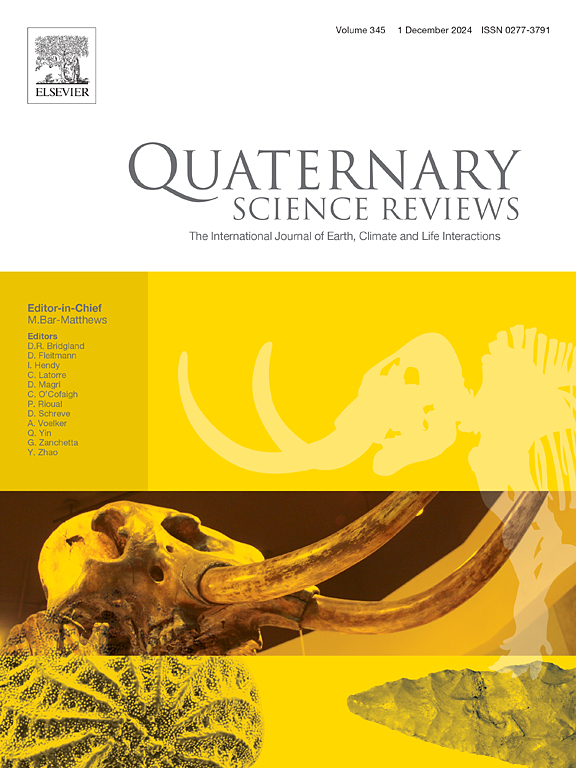犬类狼疮。Baume Traucade (israc, Gard, France)的(哺乳目,食肉目):来自后lgm时代的“类狗”个体的完整骨架
IF 3.2
1区 地球科学
Q1 GEOGRAPHY, PHYSICAL
引用次数: 0
摘要
完整保存的犬科动物骨骼可以追溯到更新世,这是罕见的发现。在这里,我们描述了在法国南部伊斯拉克市的一个洞穴遗址Baume Traucade的这样一个独特的发现,这为详细研究同一个人的一系列骨骼元素提供了难得的机会。这只犬科动物可能是一只雌性,据估计体重为26公斤,肩高为62厘米。其年龄约为16.0 ~ 15.3 cal ka BP。腰椎和肋骨上的撞击痕迹,以及一块肩胛骨上的圆形穿孔,表明这只犬科动物在死亡前不久被人类伤害过。Baume Traucade骨架与一系列参考群体进行了比较,包括化石和现存的狼,以及旧石器时代、史前和近代的狗。对其经ln变换的原始颅骨变量进行线性判别分析,后验概率为99.5%,典型概率为49.8%,将该犬科动物归为假定的旧石器时代犬类。其异速尺寸调整颅骨变量的线性判别分析将其归为同一组,后验概率为96.7%,典型概率为75.1%。此外,基于对其下颌骨和长骨的单变量分析,Baume Traucade犬科动物也显示出与假定的旧石器时代犬群最接近的亲缘关系。本文章由计算机程序翻译,如有差异,请以英文原文为准。
The Canis lupus ssp. (Mammalia, Carnivora) of the Baume Traucade (Issirac, Gard, France): A complete skeleton of a “dog-like” individual from the post-LGM
Completely preserved canid skeletons dating from the Pleistocene are rare finds. Here, we describe such a unique discovery from Baume Traucade, a cave site in the municipality of Issirac in southern France, which presents a rare opportunity to study in detail a series of skeletal elements from the same individual. This canid was likely a female with an estimated body mass of 26 kg and a shoulder height of 62 cm. It has an age of approximately 16.0 to 15.3 cal ka BP. Impact marks on the lumbar vertebrae and ribs, along with circular perforations on one of the scapulae, suggest that this canid was wounded by humans shortly before its death. The Baume Traucade skeleton is compared to a series of reference groups, including fossil and extant wolves, as well as Palaeolithic, prehistoric, and recent dogs. Linear discriminant analysis of its ln-transformed raw craniometric variables assigns this canid to the putative Palaeolithic dog group with a posterior probability of 99.5% and a typicality probability of 49.8%. Linear discriminant analysis of its allometrically size-adjusted craniometric variables assigns it to the same group with a posterior probability of 96.7% and a typicality probability of 75.1%. Furthermore, based on univariate analyses of its mandible and long bones, the Baume Traucade canid also shows the closest affinity with the group of putative Palaeolithic dogs.
求助全文
通过发布文献求助,成功后即可免费获取论文全文。
去求助
来源期刊

Quaternary Science Reviews
地学-地球科学综合
CiteScore
7.50
自引率
15.00%
发文量
388
审稿时长
3 months
期刊介绍:
Quaternary Science Reviews caters for all aspects of Quaternary science, and includes, for example, geology, geomorphology, geography, archaeology, soil science, palaeobotany, palaeontology, palaeoclimatology and the full range of applicable dating methods. The dividing line between what constitutes the review paper and one which contains new original data is not easy to establish, so QSR also publishes papers with new data especially if these perform a review function. All the Quaternary sciences are changing rapidly and subject to re-evaluation as the pace of discovery quickens; thus the diverse but comprehensive role of Quaternary Science Reviews keeps readers abreast of the wider issues relating to new developments in the field.
 求助内容:
求助内容: 应助结果提醒方式:
应助结果提醒方式:


